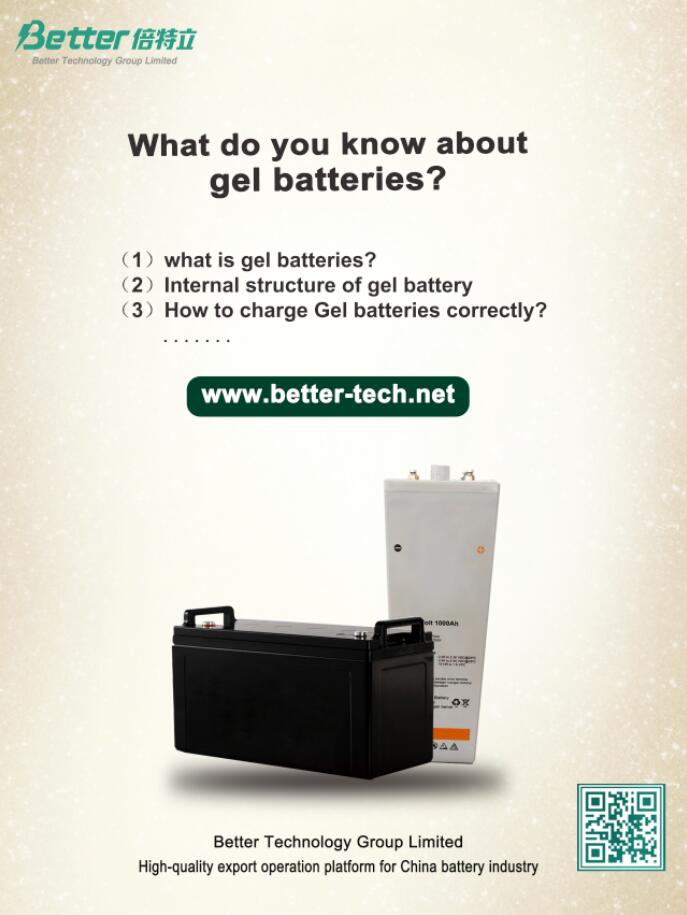
What do you know about gel batteries?
2022-03-02 16:051、 what is gel batteries?
Gel battery is one kind of development classification of lead acid battery, the method is to add gelling agent in acid, so that the acid electroliquid will turn into colloidal state. The batteries with colloidal state electrolyte are usually called gel battery. The differences between gel batteries and conventional lead-acid batteries have been developed from the initial understanding of electrolyte gelation to the study of electrochemical properties of electrolyte infrastructure, as well as the application and promotion of grids and active materials. Its most important characteristics are: with smaller industrial cost to create better quality battery, its discharge curve is flat, with high inflection point, its energy and power are more than 20% bigger than the conventional lead acid battery , the life is generally twice longer than the conventional lead acid battery, characteristics of high temperature and low temperature are much better.

2、Internal structure of gel battery
Broadly speaking, The difference between gel batteries and conventional lead-acid batteries is not only changing the electrolyte into gelatinous . For example, non-solidified water-based colloid belongs to gel battery from the structure and characteristics of electrochemical classification. Another example, bonding polymer material in the grid , commonly known as ceramic grid, it can also be seen as the application characteristics of gel batteries. A targeted coupling agent has been added to the plate formula in the laboratory, which greatly improves the reaction utilization rate of the plate active material. According to non-public information, it can reach the weight ratio energy level of 70Wh /kg. These are the application examples of gel batteries in current industrial practice and to be industrialized.
The water-based colloid is a non-disciplinary standard term, which is a name to distinguish the solidified colloid.
For the understanding of gel, academic classification and custom understanding are quite different. It is generally considered that the substance with colloidal physical state at room temperature is called Gel, while in the classification of chemical structure, it is defined as the substance with dispersed phase base structure within the range of 1-100 nanometers.
The electrochemical characteristics are determined by the colloid particle size and its surfactant
Gel battery is questioned in the history , is related to the colloidal material development and technical maturity. In the past three or two years, although nano sol has been developed, the electrochemical application of surfactant has also had more production practice, for manufacturers, it is difficult to select the suitable gel colloids in the short term.
The water-based gel is designed as an intermediate product from acid battery to gel battery, which is characterized by the removal of physical gelling framework, retention of functional polymer group characteristics and surfactants, pure liquid, used as a sulfuric acid additive, suitable for the production of all lead batteries.
Advantages: There is no Gel battery 's common industrial problems, the manufacturing process is exactly the same as acid battery, the capacity is increased by 5-15% after use, the battery life is prolonged by 50-100%, strong plate sulfation resistance, plate corrosion is much less after sulfuric acid modification. The price is also cheaper than conventional gel.
After use water-based gel additives, no need to add sodium sulfate, phosphoric acid, etc. into sulfuric acid, Standard dosage: volume ratio 8%.
3. How to charge Gel batteries correctly
(1) Do not wait for the Gel battery to run out of charge, it should be charged timely after discharge .
(2) Use Battery charger with good quality as far as possible, it is useful to improve the service life of Gel battery.
(3) The battery should be fully charged and stored in a cool and dry place, away from heat sources and direct sunlight. Storage for more than one month before use should be replenished, storage for more than three months should do a deep charge.
(4) When the weather is hot, pay attention to the battery temperature, which shall not be too high, do not charge the battery to be bulged, if too hot when touching, the charge should be stopped . In winter, the temperature is low and the battery is easy to be undercharged. The charging time can be extended appropriately (such as 10%).
(5) If the battery is a group, it should be replaced in time when there is only one wtih problem, which can prolong the life of the whole group.
